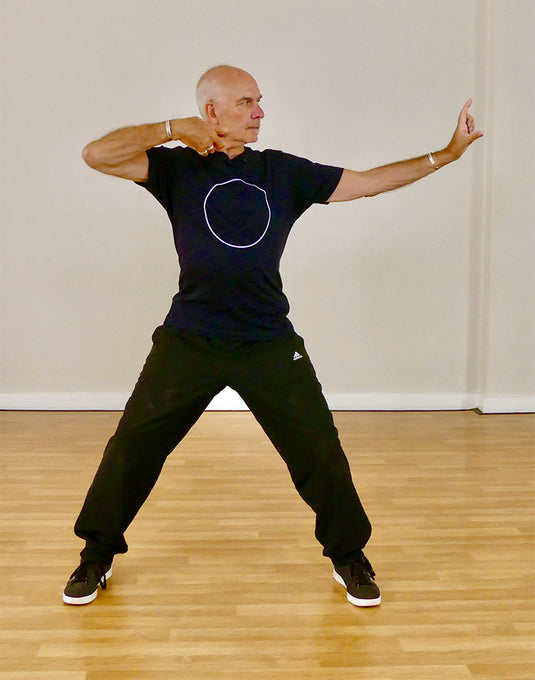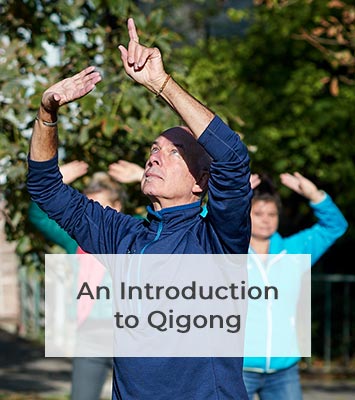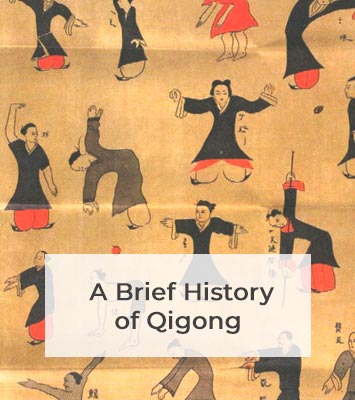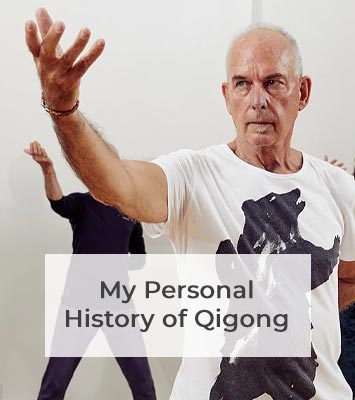GENERAL HEALTH
• Researchers at Massachussetts General Hospital studied the medical records of 4000 patients who had been advised over the years to practise meditation, yoga or tai chi for stress-related health problems and compared them to 13000 others who had not been so advised. Those who followed the practices were 43% less likely to visit the hospital, or need medical tests and emergency care. The saving per patient was estimated as $2,360 in reduced emergency care alone.
• A major review of 77 studies showed that either qigong or tai chi is able to benefit bone health, cardiopulmonary fitness, physical function, falls prevention and balance, general quality of life, immunity, and psychological factors such as anxiety, depression and self-efficacy.
• One hundred and ten adults aged from 20 to 59 years were randomly assigned to an experimental group and a control group. The experimental subjects practised baduanjin (eight pieces of brocade qigong) exercises three or more times per week for 30–60 minutes each time, over a period of 16-weeks. The results showed that, compared with the control group, body weight and body mass index (BMI) dropped in the qigong group. Flexibility was also improved significantly in those who practiced baduanjin.
• A single hour of tai chi practice can decrease the numbers of pro-inflammatory lymphocytes circulating in the blood stream.
• A review of 14 studies of 1,282 older adults with depressive symptoms, frailty, or chronic illness, found that qigong helped improve physical ability and may have positive effects on depression, balance, and functioning (the ability to do normal, everyday activities).
• Qigong significantly reduced incidence of cold and flu symptoms in elite swimmers at the University of Virginia.
• Practising tai chi produces a greater antioxidant effect in the body than walking. Either tai chi or walking were performed for six months in one-hour daily sessions under the supervision of an instructor. The results indicated that tai chi had a positive effect on lipid metabolism, causing a significant reduction in total cholesterol and LDL cholesterol compared with controls. Markers of oxidative stress also improved significantly in the tai chi group.
• Tai chi improves the flexibility of arteries (essential for a healthy cardiovascular system) and increases leg muscle strength.
• Tai chi is as effective as brisk walking (6km an hour) in raising heart rate variability (a key indicator of resilience to emotional and physical stress).
• Tai practice is more effective at decreasing ‘fight or flight’ sympathetic nervous system activity than simply resting or practising other slow-moving exercise.
• Chinese adults with at least one cardiovascular risk factor experienced significant improvements in balance, muscular strength, endurance and flexibility after three one-hour tai classes a week for 12 weeks.
ADDICTION/SUBSTANCE ABUSE
• A 2020 review of 4 studies found that qigong appeared to have a more positive effect on reducing anxiety than medication or no treatment. The review also found that qigong led to significant improvement in depressive symptoms when compared to no treatment. =
• A small pilot study from the USA suggests that qigong meditation can contribute positively to addiction treatment outcomes, with results at least as good as those of an established stress management program, especially for females.
ARTERIAL STIFFNESS
Alongside a healthy diet, the main way to counter arterial stiffness is the right kind of exercise. And since strength is also a desirable outcome of exercise, the ideal practice will benefit both. However neither of the two most popular exercises appears to have this dual effect. While aerobic exercise does reduce arterial flexibility, it does not build strength, resistance training builds strength it does not seem to reduce arterial stiffness. Luckily there is strong evidence that qigong and tai chi do both – building core and leg strength while elastically lengthening and releasing through the whole body.
ARTHRITIS
• In the largest study to date carried out under the Arthritis Foundation Tai Chi program, over three hundred sufferers who practised twelve tai chi based movements experienced improvements in pain, fatigue, stiffness, wellbeing and ability to reach.
• Tai chi helps strengthen people suffering from arthritis, enabling them to walk further and faster and reducing pain and stiffness.
• Tai chi offers both physical and mental benefits for patients with rheumatoid arthritis, with significant improvements in balance, grip strength, pinch strength, 50 foot walk time, self reported joint pain, swollen joint count, tender joint count and self-efficacy in relation to pain control.
• A systematic review by Danish authors has found moderate evidence for short-term improvement of pain, physical function and stiffness in patients with osteoarthritis of the knee who practice tai chi.
• Taichi qigong significantly improved quality of life and time taken to walk six miles in patients with knee arthritis.
• Rheumatoid arthritis sufferers who practised tai chi twice a week for 12 weeks, experienced improved lower-limb muscle function, improved physical condition, greater confidence in moving, better balance and less pain during exercise and in daily life. Other patient experiences included stress reduction, and increased body awareness and confidence in moving.
BALANCE/FALLING
• Tai chi has consistently been shown to be the most effective method for improving balance and reducing rates of falling in older adults. When older people fall they often break bones (especially the hip bone in women with osteoarthritic weakening of the bones). This can not only lead to disability and increased risk of dying but puts a massive financial burden on health services.
• A 2019 review found that qigong improves balance and reduces rates if falling in the elderly with similar or better effects than other interventions.
See also:
Effect of tai chi on physical function, fall rates and quality of life among older stroke survivors
Tai chi and postural stability in patients with Parkinson’s disease
CANCER
• An Australian team has found that qigong has multiple health benefits for cancer patients. After ten weeks of practice the qigong group demonstrated significantly improved cognitive function and quality of life compared with controls, as well as reduced blood levels of C-reactive protein (CRP), a biomarker of inflammation.
• Another Australian study found that gentle qigong significantly increased quality of life in cancer patients, with reductions in tiredness, mood disturbance and levels of the inflammatory marker serum C-reactive protein.
• Two reviews in 2017 and 2019 suggest that qigong has positive effects on anxiety, stress, depressive symptoms, and overall quality of life in cancer patients.
• Both quiet (meditative) and more active qigong help strengthen cancer patients as well as improving their mental quality of life.
• A Chinese study reports that just five weekly sessions of qigong resulted in reduced depression and fatigue in women undergoing radiotherapy for breast cancer, compared to controls.Those women with the greatest depression at the start of the study experienced the most benefit.
• Tai chi helps strengthen people suffering from cancer, enabling them to walk further and faster.
• Tai chi reduces fatigue in lung cancer patients undergoing chemotherapy.
• Tai chi has been shown to reduce insomnia in breast cancer survivors, contributing to reductions in depression and tiredness.
• Tai chi reduces the likelihood of older cancer survivors to suffer high blood pressure, chronic inflammation and high levels of the stress hormone cortisol.
• Tai chi was found to help prevent weight gain and maintain lean body mass in breast cancer survivors by stabilising insulin levels.
• Tai chi appears to help cancer patients with cognitive problems that arise as a side effect of chemotherapy treatment. Twenty-three women participated in a one-hour tai chi class twice a week for 10 weeks. After 10 weeks of tai chi (twice a week for one hour), participants reported better psychological functioning and gained higher scores on neuropsychological tests (memory, executive functioning, language, and attention). They also demonstrated improved balance.
CHRONIC FATIGUE
• A Hong Kong study has found that compared to a control group, qigong (three months of regular practice) significantly improved total fatigue, physical fatigue and depression in patients suffering from chronic fatigue syndrome.
• Another Hong Kong study found that regular qigong practice (30 minutes a day for 12 weeks) significantly improved fatigue symptoms and mental function in sufferers of chronic fatigue syndrome.
• A UK study found that daily qigong practice (15 minutes) significantly improved sleep, energy, social activity, pain levels, mobility and mental attitude in people with chronic fatigue.
COPD (Chronic obstructive pulmonary disease)
• Hong Kong researchers say that a form of qigong (taichi qigong) can lead to sustained improvements in the health of COPD sufferers. They experienced a 17% increase in the distance they could walk in six minutes and a 11% improvement in mean forced expiratory volume (FEV). A control group who exercised simply by walking found no significant improvements and in fact had a reduction in FEV.
• A 2020 review of 32 studies found that adding qigong to primary treatment improved lung function, quality of life and ability to exercise in patients with COPD.
• Tai chi helps strengthen people suffering from chronic obstructive pulmonary disease, enabling them to walk further and faster.
DIABETES
• A recent review by American authors suggests that qigong exercise shows promising results for treating various aspects of type 2 diabetes mellitus. These include blood glucose, triglycerides, total cholesterol, weight, BMI and insulin resistance. However, a large variation in styles and definitions of qigong exists and this, along with inconsistencies in control groups, research subjects and diabetic markers analysed, makes firm conclusions impossible to draw and means further well-designed RCTs are needed to confirm the benefits.
• Twelve weeks of qigong practice resulted in improvements in body weight, waist circumference, leg strength and indicators of diabetes control (HbA1c, insulin resistance and fasting blood insulin) in patients with type-2 diabetes.
• Twelve weeks of qigong therapy resulted in significant reductions in fasting glucose levels in patients with type-2 diabetes compared to controls. The qigong group additionally demonstrated trends toward improvement in insulin resistance and HbA1C (glycosylated haemoglobin) levels.
• A 12-week programme of tai chi and qigong prompted a significant fall in blood glucose levels and significant improvements in other indicators of metabolic syndrome in 11 middle-aged to older adults. At the end of 12 weeks, they had lost an average of 3kg in weight and their waist size had dropped by an average of 3cm. Their blood pressure and insulin resistance also improved significantly. Participants said they slept better, had more energy, felt less pain and had fewer food cravings while on the programme.
• Tai chi is helpful for patients with diabetic neuropathy, reducing symptoms and improving glucose control, balance and quality of life.
• A prospective literature review by American authors suggests that qigong exercise shows promising results for treating various aspects of type 2 diabetes mellitus (T2DM). These include blood glucose, triglycerides, total cholesterol, weight, BMI and insulin resistance. However, a large variation in styles and definitions of qigong exists and this, along with inconsistencies in control groups, research subjects and diabetic markers analysed, makes firm conclusions impossible to draw and means further well-designed RCTs are needed to confirm the benefits.
HEART/ CARDIOVASCULAR DISEASE
• A meta-analysis (study of 35 pieces of research) has shown that qigong and tai chi can reduce the risk of stroke by 41% and heart attack by 22%. Additional benefits include lowered cholesterol, better overall physical functioning and reduced depression.
• Tai chi helps strengthen people suffering from heart failure, enabling them to walk further and faster.
• A 2020 review of 33 studies found that adding qigong or tai chi to regular care for people with chronic heart failure led to improvements in peak oxygen consumption (a measure of cardiorespiratory fitness), 6-minute walking distance (a measure of exercise tolerance), and quality of life.
• Just eight weeks of tai chi helps reduce the inflammation associated with cardiovascular diseases in women (aged 35 – 50).
• Patients with coronary artery disease who practised 90 minute sessions of Yang style tai chi weekly for six months significantly reduced their risk of future cardiac events compared to a control group.
• Tai chi (four times a week for one year) can help regulate the autonomic nervous system in patients with coronary heart disease. Compared to controls, the tai chi group showed significant improvement in baroreflex sensitivity (a marker of the activity of the autonomic nervous system), suggesting increased vagal activity and a decreased risk for sickness and death.
HIGH BLOOD PRESSURE
• Twelve weeks (35 minutes per day, five days per week for 12 weeks) of qigong practised by elderly wheelchair-bound adults lowered blood pressure, as well as improving psychological health.
• Tai chi (60 minutes per day, six days per week for 12 weeks) practised by patients with essential hypertension (high blood pressure) significantly lowered systolic blood pressure, diastolic blood pressure and mean arterial pressure. Levels of blood lipids (fatty substances in blood) also improved significantly. No changes were observed in a control group.
• A systematic review of qigong in the treatment of high blood pressure concluded that it is an effective therapy.
IMMUNE FUNCTION
• Researchers in the USA have found that a combination of tai chi and qigong enhanced older adults’ immune responses to the flu vaccine.
• Tai chi can boost the immune system of patients with shingles to similar levels as those who use a shingles vaccine. The tai chi group also showed significant improvements in scores for physical functioning, bodily pain, vitality, and mental health.
MENOPAUSE
• Taking part in a tai chi programme has multiple health benefits for post-menopausal women, particularly for those suffering from age-related loss of muscle strength. After 12 weeks of tai chi training, the women showed a significant decrease in body weight, fat mass percentage, and skeletal muscle mass, whereas handgrip strength, functional capacity test scores, and general health perception significantly increased. In addition, significantly lower systolic and diastolic blood pressures were observed
• Healthy post-menopausal Hong Kong women who practised tai chi five times a week for a year showed a slower rate of bone mineral density loss (osteoporosis) at the lumbar spine, proximal femur and distal tibia) and a reduced fracture rate.
MENTAL HEALTH
• Tai chi has been found to reduce stress levels in healthy individuals. Australian researchers randomised 50 participants into tai chi, exercise and waiting-list groups. The tai chi group took part in weekly one-hour instructor-led sessions (simplified 24 posture Taiji Quan) during the first six weeks, followed by six weeks of unsupported practice (they had to complete at least five hours of tai chi practice per week). Significant improvements were observed from baseline for both the tai chi and the exercise groups for anxiety, mental health and vitality and superior outcomes were observed for tai chi compared to waiting list.
• A 2019 review of over 60 year olds found that qigong improved cognition and memory but only when practice was prolonged and consistent (more than 12 weeks, 3-7 sessions a week for 45-60 minutes a time).
• A systematic review of 40 previous studies by US researchers has found that regular tai chi practice significantly increased psychological well-being, with reduction of stress, anxiety, and depression, enhanced mood and increased self-esteem, both in healthy participants and in patients with a variety chronic conditions.
• 30 minutes of qigong practice is enough to improve mood according to a study of forty-one regular qigong practitioners. After practice they reported more positive mood states, reduced anxiety, and enhanced perceived pleasure.
• Six weeks of qigong training was enough to significantly reduce both stress and pain intensity in American hospital staff.
• Tai Chi can enhance cognitive function (reasoning, memory , attention, and language) in older adults, particularly in the realm of executive functioning (the ability to successfully manage the way we act in the world) in individuals without significant impairment.
• A Chinese-Japanese study of over 500 long-term tai chi practitioners has concluded that it can help to prevent depression.
• Three months of tai chi significantly reduced symptoms of stress in a group asked to speak in public and perform mental arithmetic. Compared to a control group, practitioners exhibited significantly lower stress-induced increases in heart rate and levels of salivary cortisol, reported a smaller increase in perceived stressfulness and maintained a higher level of calmness in response to induced stress.
• Practising tai chi helps improve attention in healthy young adults.
• A group of depressed elders who practised qigong for 12 weeks experienced a significant reduction in depression compared to a similar group who met for a newspaper reading programme. The qigong group also showed improvement in self-efficacy, self-concept of physical well-being, right-hand grip strength and decreased cortisol levels.
• Tai chi has greater effect on increasing brain volume and improving cognitive function in a group of elders who practised for 40 weeks, compared to groups who walked, gathered for social interaction, or had no intervention.
• The beneficial effects of long-term practice of qigong meditation (increased awareness and healthy detachment) have been shown by ECG studies of brain activity to carry over into everyday life.
• Older adults who practise tai chi perform better in cognitive tests than those who take part in conventional exercise or no exercise at all.
• Tai chi appears to delay cognitive decline in older people with mild dementia compared to the effects of stretching and toning exercises.
• Tai chi adds greater benefit to standard depression treatment in elderly adults than health education. Greater improvements in quality of life, memory and cognition, and overall energy were also seen in the tai chi group.
• Chinese scientists report that long-term tai chi practice can induce regional structural changes in practitioners’ brains. Tai chi practitioners showed significantly thicker areas of cortex in the precentral gyrus (responsible for observation and execution of motor tasks), insula sulcus (involved in the subjective sense of the inner body, and the integration of information relating to bodily states into higher-order cognitive and emotional processes) and middle frontal sulcus (responsible for motor planning, integration of emotion and cognition, and executive function) in the right hemisphere. In the left hemisphere, the cortical areas of the superior temporal gyrus, medial occipito-temporal sulcus and lingual sulcus (brain regions involved in spatial navigation and spatial information acquisition) were thicker in tai chi practitioners. The researchers also found that thickening of the left medial occipito-temporal sulcus and lingual sulcus was correlated with a greater intensity (total hours per week) of tai chi practice, providing further evidence that long-term tai chi practice leads to structural alterations in brain grey matter.
• Tai chi (TC) can reduce stress levels in healthy individuals. Australian researchers randomised 50 participants into TC, exercise and wait-list (WL) groups. Participants took part in weekly one-hour instructor-led TC sessions (simplified 24 posture Taiji Quan) during the first six weeks, followed by six weeks of unsupported practice. It was required that participants complete at least five hours of TC practice per week. Significant improvements were observed from baseline for both TC and exercise groups for both state and trait anxiety, mental health and vitality. Superior outcomes were observed for TC when compared with WL for state and trait anxiety and mental health.
MULTIPLE SCLEROSIS
• A study of 32 MS patients who practised tai chi for 90 minutes twice a week for six months recorded significant and consistent improvements in balance, coordination and depression symptoms, compared to a similar group treated conventionally.
PAIN
• Tai chi can lead to rapid relief of chronic pain from osteoarthritis, low back pain and osteoporosis. Six weeks of tai chi was the minimum required, with better results the longer the practice continued.
• Qigong can help reduce pain and improve sleep quality and physical and mental function in patients with fibromyalgia. Better results were found in those who practised daily for n30 to 40 minutes.
• Tai chi has been shown to be effective a relieving several kinds of chronic pain. This study showed one interesting reason that it can help improve back pain and that is reduction in mental ‘catastrophising’ (the tendency to interpret pain in a fearful and demoralised way).
• Tai chi practised for 10 weeks improved chronic back pain and self-reported disability scores more than usual care.
• Tai chi is more effective at relieving the pain and other symptoms of fibromyalgia than conventional exercises.
PARKINSON’S DISEASE
• Parkinson’s disease patents who practised tai chi twice-weekly for 24 weeks, 60 minutes per session, improved their postural stability and walking ability and had a reduced risk of falling. The tai chi group performed consistently better than a stretching group control in how far they could lean without losing balance, and than a resistance training group on balance and stride-length measures.
• A 2020 review of 7 studies found that qigong improved movement, walking ability and balance in Parkinson’s disease.
PROSTATE HEALTH
• Tai chi has been found to improve lower urinary tract symptoms, quality of life and testosterone levels in patients with enlarged prostate (benign prostate hypertrophy).
SLEEP
• A UK study found that daily qigong practice (15 minutes) significantly improved sleep, energy, social activity, pain levels, mobility and mental attitude in people with chronic fatigue.
• Older adults with moderate sleep problems practised either tai chi (3 times a week for 24 weeks) or a similar amount of seated exercises which emphasised controlled breathing, stretching and relaxation (less physically demanding and with less meditation component than the tai chi group). At the end of the study, the tai chi group reported significant improvement in five out of seven sleep parameters compared to the exercise group and scored significantly better on all physical measures and quality of life scores
TINNITUS
• German researchers report that qigong training could be a useful additional therapy for patients with tinnitus after a study found improvement of symptoms (still present after at least three months) compared to a control group.






